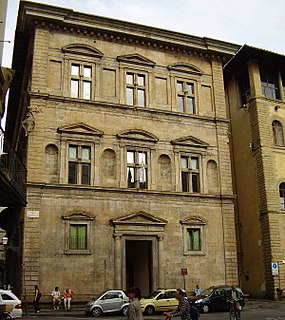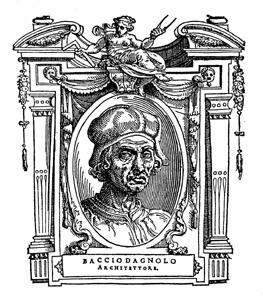
Baccio D'Agnolo, born Bartolomeo Baglioni, was an Italian woodcarver, sculptor and architect from Florence.

Palazzo Strozzi is a palace in Florence, Italy.
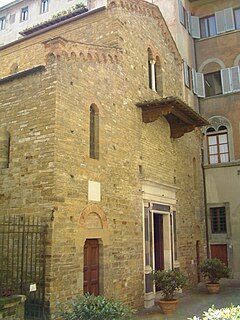
The Church of Santi Apostoli is a Romanesque-style, Roman Catholic church in the historic center of Florence, in the Tuscany region of Italy. It is among the oldest church buildings in Florence.
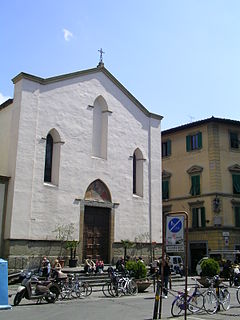
Sant'Ambrogio is a Roman Catholic church in Florence, region of Tuscany, Italy. It is named in honour of St Ambrose.

Via de' Tornabuoni, or Via Tornabuoni, is a street at the center of Florence, Italy, that goes from Antinori square to ponte Santa Trinita, across Santa Trinita square, characterized by the presence of fashion boutiques.

Piazza del Duomo is located in the heart of the historic center of Florence, . It is one of the most visited places in Europe and the world and in Florence, the most visited area of the city. The square contains the Florence Cathedral with the Cupola del Brunelleschi, the Giotto's Campanile, the Florence Baptistery, the Loggia del Bigallo, the Opera del Duomo Museum, and the Arcivescovile and Canonici's palace. The west zone of this square is called Piazza San Giovanni.

Palazzo Uguccioni is a Renaissance palace on the Piazza della Signoria in Florence, central Italy.

Palazzo Antinori is a Renaissance palace located at the north end of Via de' Tornabuoni, where it makes an odd corner with Via dei Pecori, Via del Trebbio, and converts into Via dei Rondinelli, in Florence, region of Tuscany, Italy.

Palazzo Cocchi-Serristori is a Renaissance-style palace in Piazza Santa Croce, Florence, Italy. It presently houses offices of a regional council of Florence.
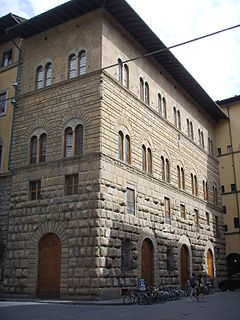
Palazzo dello Strozzino is a Renaissance palace in Florence, region of Tuscany, Italy. The stone Renaissance facade is located on Piazza degli Strozzi, diagonal to the Southeast corner of the imposing Palazzo Strozzi. The Northern façade on Via dei Anselmi houses the entrance to the Cinema Odeon.

The Fountain of Neptune is a fountain in Florence, Italy, situated on the Piazza della Signoria, in front of the Palazzo Vecchio. Made of marble and bronze, the fountain was commissioned in 1565 and designed by Baccio Bandinelli. It is the work of the sculptor Bartolomeo Ammannati with some elements created by collaborators. For example, the bronze sea-horses are the work of Giovanni da Bologna, often called Giambologna.

The Palazzo Panciatichi is a Renaissance palace located on Via Camillo Cavour 2 in the quartiere of San Giovanni, Florence, region of Tuscany, Italy. A different Palazzo Panciatichi-Ximenes or Ximenes-da Sangallo is located at Borgo Pinti 68, corner of via Giusti, in Florence.

The Palazzo Nasi, also known as the Palazzo Torrigiani or Palazzo Scarlatti, is a palace located at Piazza de' Mozzi 4, down the street where the Ponte alle Grazie enters the Oltrarno, in Florence, Tuscany, Italy. Another Palazzo Torrigiani Del Nero, with a Mannerist or late-Renaissance-style facade stands closer to the river. Both palaces also once belonged to the Nasi. The palace is a few steps from the Palazzo Mozzi.
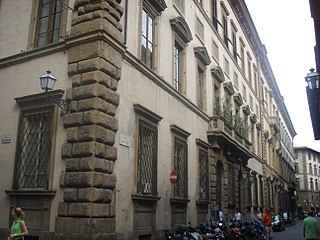
The Palazzo Pucci is a palace located at Via dei Pucci #4 in central Florence in the region of Tuscany, Italy. The façade of the palace spans from Via dei Servi to Via Ricasoli.
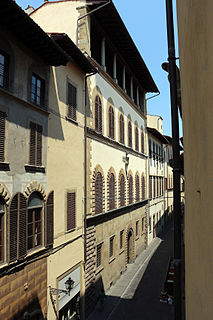
Palazzo Ginori is a Renaissance-style palace in Via de' Ginori # 11 in the Quartieri San Giovanni of the city of Florence, Italy.
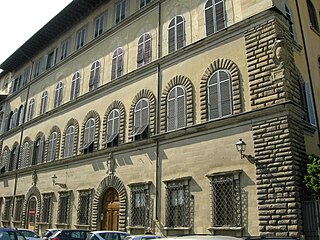
The Palazzo Torrigiani Del Nero is a Renaissance-style palace located at Piazza de' Mozzi 5, down the street where the Ponte alle Grazie enters the Oltrarno in Florence, Tuscany, Italy. Another Palazzo Torrigiani stands alongside, the smaller Palazzo Nasi. Both palaces also once belonged to the Nasi.
The Museo Horne is a museum focusing on art and furnishings of the 14th and 15th centuries, located in the former Palazzo Corsi, on via de' Benci number 6 in Florence, region of Tuscany, Italy.
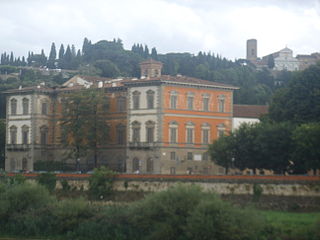
Palazzo Serristori is a Renaissance style palace located between Piazza Demidoff and the Lungarno Serristori in Oltrarno, in the neighborhood of San Niccolò of Florence, region of Tuscany, Italy.

The Palazzo Lanfranchi-Toscanelli, presently the local State Archives, is a Renaissance-style palace located on Lungarno Mediceo #30, in the city of Pisa, region of Tuscany, Italy. Since 1913 the building has housed the Archivio di Stato di Pisa.




